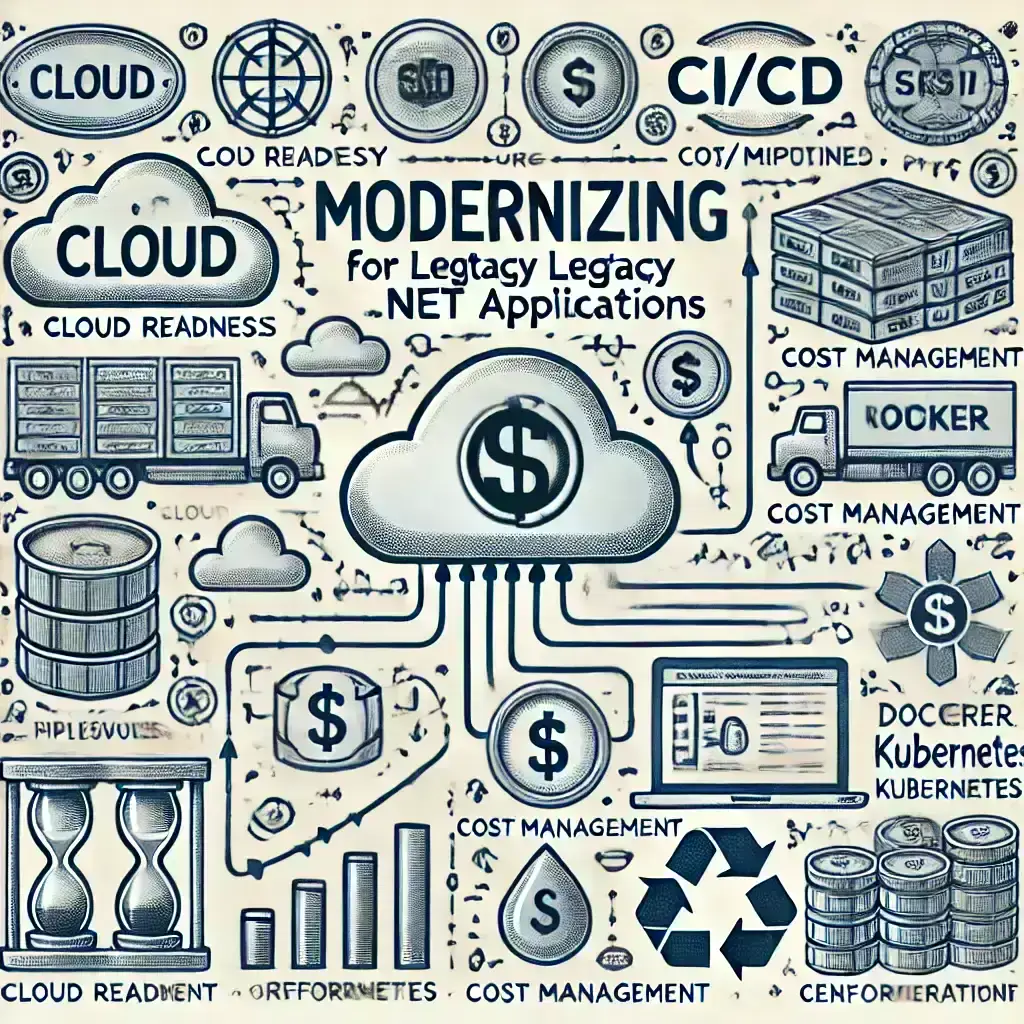· iWork Technologies Team · Product Modernization · 6 min read
Infrastructure Considerations for Modernizing Legacy .NET Applications
Prepare your infrastructure for modernized .NET applications with cloud readiness, CI/CD pipelines, cost management, and containerization strategies.

Infrastructure Considerations
In the fifth installment of our 11-part series on modernizing legacy .NET applications, we turn our attention to the infrastructure considerations that are critical for a successful modernization effort. As you transition your legacy applications to modern architectures, preparing your infrastructure to support these changes is essential. This post will cover key topics such as cloud readiness, setting up CI/CD pipelines, managing costs in the cloud, and leveraging containerization and orchestration technologies like Docker and Kubernetes.
Cloud Readiness: Preparing Infrastructure for Cloud-Based Deployment
Moving legacy .NET applications to the cloud can offer significant benefits, including improved scalability, availability, and disaster recovery. However, transitioning to a cloud-based infrastructure requires careful preparation to ensure that your application is cloud-ready.
Key Steps for Cloud Readiness
-
Assess Current Infrastructure: Begin by evaluating your existing on-premises infrastructure to identify components that may need to be reconfigured or replaced. Consider the compatibility of your current systems with cloud services and determine whether any legacy dependencies could pose challenges.
-
Select the Right Cloud Provider: Choose a cloud provider that aligns with your specific needs. Azure, AWS, and Google Cloud all offer robust support for .NET applications, but each has its unique strengths and services. Evaluate factors such as data center locations, pricing, available services, and integration with existing tools.
-
Re-architect for the Cloud: Transitioning to the cloud often involves re-architecting parts of your application to take full advantage of cloud-native features. This might include decoupling components, leveraging serverless functions, or adopting a microservices architecture to enhance scalability and resilience.
-
Security and Compliance: Ensure that your cloud infrastructure meets all security and compliance requirements. Implement best practices such as encryption, identity and access management (IAM), and regular security audits to protect your data and applications.
By thoroughly preparing your infrastructure for the cloud, you can ensure a smoother transition and fully capitalize on the benefits of cloud-based deployment.
CI/CD Pipelines: Automating Deployment and Integration with Modern Tools
One of the key aspects of modernizing a .NET application is streamlining the development and deployment process. Continuous Integration and Continuous Deployment (CI/CD) pipelines play a crucial role in automating these processes, enabling faster and more reliable releases.
Setting Up CI/CD Pipelines
-
Continuous Integration (CI): Implement CI practices by automating the process of integrating code changes from multiple developers into a shared repository. Tools like Azure DevOps, Jenkins, and GitHub Actions can help automate build processes, run tests, and ensure that code is always in a deployable state.
-
Continuous Deployment (CD): Automate the deployment process by setting up CD pipelines that automatically deploy changes to staging or production environments after passing the necessary tests. This reduces manual intervention, speeds up release cycles, and minimizes the risk of human error.
-
Infrastructure as Code (IaC): Use IaC tools like Terraform or Azure Resource Manager (ARM) templates to automate the provisioning and management of your cloud infrastructure. This ensures consistency across environments and makes it easier to manage infrastructure changes through version control.
-
Monitoring and Logging: Integrate monitoring and logging tools into your CI/CD pipelines to provide real-time visibility into the health and performance of your applications. Tools like Azure Monitor, Prometheus, and ELK Stack can help you track metrics, detect issues early, and respond quickly to incidents.
-
Implementing CI/CD pipelines: This not only accelerates the development process but also improves the quality and reliability of your deployments, enabling you to deliver new features and updates with confidence.
-
Cost Management: Optimizing Cloud Infrastructure for Performance and Cost Efficiency One of the primary challenges of moving to the cloud is managing costs while maintaining optimal performance. Without proper planning, cloud expenses can quickly spiral out of control, eroding the financial benefits of cloud adoption.
Strategies for Cost Management
-
Right-Sizing Resources: Regularly assess your cloud resources to ensure they are appropriately sized for your needs. Over-provisioning can lead to unnecessary costs, while under-provisioning can impact performance. Use tools like Azure Cost Management or AWS Cost Explorer to monitor and optimize resource usage.
-
Auto-Scaling: Implement auto-scaling to dynamically adjust resource allocation based on demand. This ensures that you only pay for the resources you need while maintaining performance during peak usage periods.
-
Reserved Instances: Consider using reserved instances or savings plans for predictable workloads. These options allow you to commit to using specific resources over a period of time in exchange for significant cost savings compared to on-demand pricing.
-
Serverless Computing: For certain workloads, serverless computing models like Azure Functions or AWS Lambda can offer cost-effective alternatives to traditional VM-based deployments. With serverless, you only pay for the compute time you use, making it ideal for variable or low-traffic applications.
-
Cost Allocation and Tagging: Implement tagging policies to allocate and track costs across different teams, projects, or departments. This helps in identifying areas where cost optimizations can be made and ensures accountability for cloud spending.
By actively managing and optimizing your cloud costs, you can maximize the return on investment from your cloud infrastructure while maintaining high performance and availability.
Containerization and Orchestration: Using Docker, Kubernetes, and More for Deployment and Scaling
Containerization and orchestration technologies have become essential tools for modernizing legacy .NET applications. By packaging your applications into containers and using orchestration platforms like Kubernetes, you can achieve greater consistency, scalability, and efficiency in deployment.
Containerization with Docker
-
Overview: Docker allows you to package your application, along with its dependencies, into a standardized unit called a container. This ensures that the application runs consistently across different environments, whether on a developer’s laptop, in a test environment, or in production.
-
Benefits: Docker simplifies the deployment process, reduces compatibility issues, and enables faster scaling. It also makes it easier to manage application dependencies and versioning.
-
Getting Started: Begin by containerizing your legacy .NET application using Docker. This involves creating a Dockerfile that defines the environment and dependencies your application needs to run. You can then build and run the container locally to test it before deploying it to production.
Orchestration with Kubernetes
-
Overview: Kubernetes is an orchestration platform that automates the deployment, scaling, and management of containerized applications. It provides features like self-healing, load balancing, and automated rollout/rollbacks, making it easier to manage complex applications at scale.
-
Benefits: Kubernetes enables you to run your applications across clusters of machines, ensuring high availability and resilience. It also simplifies the management of microservices architectures by handling service discovery, configuration management, and scaling automatically.
-
Implementing Kubernetes: Start by deploying your Dockerized .NET application to a Kubernetes cluster. You can use managed Kubernetes services like Azure Kubernetes Service (AKS) or Amazon Elastic Kubernetes Service (EKS) to simplify the setup and management of your cluster. Define your application’s deployment and scaling requirements using Kubernetes manifests, and use Helm charts to manage configurations.
-
Advanced Features: Explore advanced Kubernetes features like ingress controllers for managing external access, StatefulSets for managing stateful applications, and Custom Resource Definitions (CRDs) for extending Kubernetes functionality to meet specific needs.
Containerization and orchestration provide a robust foundation for deploying and scaling modernized .NET applications, ensuring consistency, reliability, and efficiency across your infrastructure.
Conclusion
Infrastructure considerations are a critical component of any successful modernization effort. By preparing your infrastructure for the cloud, implementing CI/CD pipelines, managing costs effectively, and leveraging containerization and orchestration technologies, you can create a robust, scalable, and efficient environment for your modernized .NET applications.
In the next part of this series, we will explore strategies for data migration and management, ensuring that your data is securely and seamlessly integrated into your modernized infrastructure.



